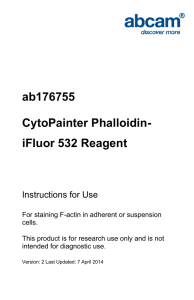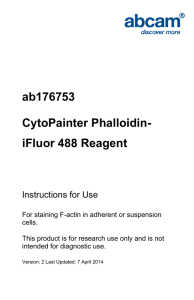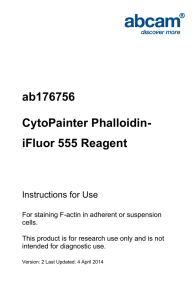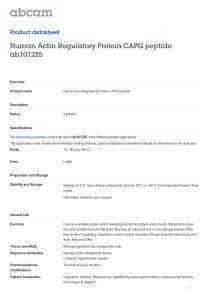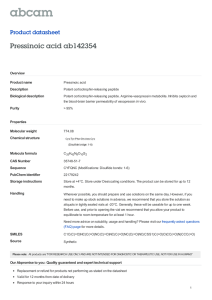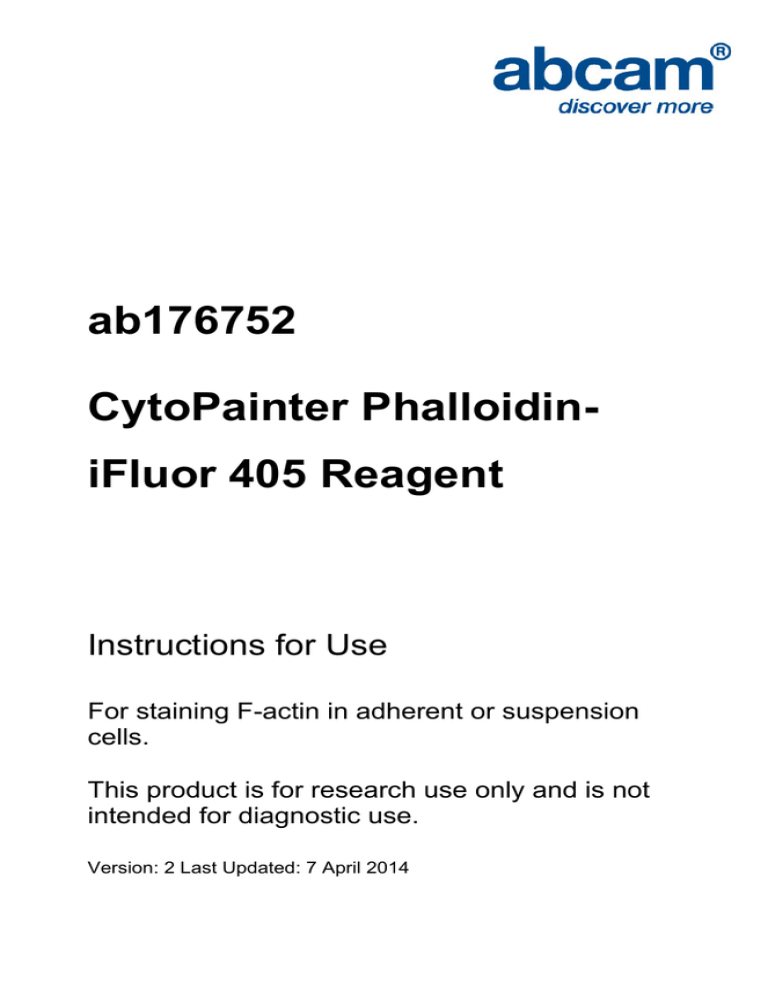
ab176752
CytoPainter PhalloidiniFluor 405 Reagent
Instructions for Use
For staining F-actin in adherent or suspension
cells.
This product is for research use only and is not
intended for diagnostic use.
Version: 2 Last Updated: 7 April 2014
1
Table of Contents
1.
Introduction
3
2.
Protocol Summary
5
3.
Materials Supplied
5
4.
Storage and Stability
6
5.
Materials Required, Not Supplied
6
6.
Assay Protocol
7
7.
Data Analysis
9
8.
Troubleshooting
10
2
1. Introduction
Actin is a globular, roughly 42-kDa protein found in almost all
eukaryotic cells. It is also one of the most highly conserved proteins,
differing by no more than 20% in species as diverse as algae and
humans. Actin is the monomeric subunit of two types of filaments in
cells: microfilaments, one of the three major components of the
cytoskeleton, and thin filaments, part of the contractile apparatus in
muscle cells. Thus, actin participates in many important cellular
processes including muscle contraction, cell motility, cell division and
cytokinesis, vesicle and organelle movement, cell signaling, as well
as the establishment and maintenance of cell junctions and cell
shape.
CytoPainter Phalloidin-iFluor 405 Reagent (ab176752) is a blue
fluorescent phalloidin conjugate (equivalent to Alexa Fluor® 405labeled phalloidin) that selectively binds to actin filaments (also
known as F-actin). Used at nanomolar concentrations, phalloidin
derivatives are convenient probes for labeling, identifying and
quantitating F-actins in formaldehyde-fixed and permeabilized tissue
sections, cell cultures or cell-free experiments. Phalloidin binds to
actin filaments much more tightly than to actin monomers, leading to
a decrease in the dissociation rate of actin subunits from filament
ends, essentially stabilizing actin filaments through the prevention of
filament depolymerization. Moreover, phalloidin is found to inhibit the
ATP hydrolysis activity of F-actin. Phalloidin functions differently at
3
various concentrations in cells. When introduced into the cytoplasm
at low concentrations, phalloidin recruits the less polymerized forms
of cytoplasmic actin as well as filamin into stable "islands" of
aggregated actin polymers, yet it does not interfere with stress fibers,
i.e. thick bundles of microfilaments.
Phalloidin is therefore a useful tool for investigating the distribution of
F-actin in cells by labeling phalloidin with fluorescent analogs and
using them to stain actin filaments for microscopy. Fluorescent
derivatives of phalloidin have turned out to be enormously useful in
localizing actin filaments in living or fixed cells as well as for
visualizing individual actin filaments in vitro.
CytoPainter Phalloidin-iFluor 405 Reagent (ab176752) can be
detected at Ex/Em = 400/421 nm.
Figure 1. Chemical structure of Phalloidin-iFluor 405 Conjugate.
4
2. Protocol Summary
Prepare samples in microplate wells
Remove liquid from samples in the plate
Add phalloidin-ifluor reagent
Stain cells at RT for 20-90 min
Wash cells
Examine the specimen under the microscope
3. Materials Supplied
Item
Phalloidin-iFluor 405 Conjugate
Quantity
1 x 300 tests
5
4. Storage and Stability
Upon receipt, store kit at -20°C. Avoid exposure to light. Reagent is
stable for at least 6 months if stored properly. Avoid repeated freeze/
thaw cycles.
Note: Phalloidin is toxic, although the amount of toxin present in a
vial could be lethal only to a mosquito (LD50 of phalloidin = 2 mg/kg),
it should be handled with care.
5. Materials Required, Not Supplied
PBS with 1% BSA
3-4% formaldehyde in PBS
0.1% Triton X-100 in PBS (optional)
Fluorescence microscope equipped with the desired filter
set
Pipettes and pipette tips
Coverslips, petri dishes or well plates to grow cells
6
6. Assay Protocol
1. Reagent Preparation:
a)
Prepare 1X Phalloidin conjugate working solution by adding
1 µL of 1000X Phalloidin conjugate DMSO solution to 1 mL
of PBS with 1% BSA.
NOTE: The unused 1000X DMSO stock solution of
phalloidin conjugate should be aliquoted and stored at
-20 C. protected from light.
NOTE: Different cell types might be stained differently. The
concentration of phalloidin conjugate working solution
should be prepared accordingly.
2. Sample Staining:
a)
Perform formaldehyde fixation. Incubate cells with 3.0–4.0
% formaldehyde in PBS at room temperature for 10–30
minutes.
Note: Avoid any methanol containing fixatives since
methanol can disrupt actin during the fixation process. The
preferred fixative is methanol-free formaldehyde.
b)
Rinse the fixed cells 2–3 times in PBS.
c)
Optional: Add 0.1% Triton X-100 in PBS into fixed cells
(from Step b) for 3 to 5 minutes to increase permeability.
Rinse the cells 2–3 times in PBS.
7
d)
Add 100 μL/well (96-well plate) of phalloidin conjugate
working solution (from Step 1c) into the fixed cells (from
Step 2b or 2c), and stain the cells at room temperature for
20 to 90 minutes.
e)
Rinse cells gently with PBS 2 to 3 times to remove excess
phalloidin conjugate before plating, sealing and imaging
under microscope.
8
7. Data Analysis
Figure 2. Excitation and emission spectra of CytoPainter PhalloidiniFluor 405 Reagent (ab176752).
9
8. Troubleshooting
Problem
Reason
Solution
Too low dye
concentration or
incubation time
insufficient
Increase
concentration or
incubation time
Cells observed at
incorrect wavelength
Ensure you are using
appropriate filter
settings
Cells do not
appear healthy
Cells require serum to
remain healthy
Add serum to stain
and wash solutions.
Try range 2 – 10%
serum.
Nuclear
counterstain is
too bright
Different microscopes,
cameras and filters may
make some signals
appear very bright
Reduce concentration
of nuclear
counterstain or
shorten exposure
time.
Lysosomes not
sufficiently
stained.
10
UK, EU and ROW
Email: technical@abcam.com | Tel: +44-(0)1223-696000
Austria
Email: wissenschaftlicherdienst@abcam.com | Tel: 019-288-259
France
Email: supportscientifique@abcam.com | Tel: 01-46-94-62-96
Germany
Email: wissenschaftlicherdienst@abcam.com | Tel: 030-896-779-154
Spain
Email: soportecientifico@abcam.com | Tel: 911-146-554
Switzerland
Email: technical@abcam.com
Tel (Deutsch): 0435-016-424 | Tel (Français): 0615-000-530
US and Latin America
Email: us.technical@abcam.com | Tel: 888-77-ABCAM (22226)
Canada
Email: ca.technical@abcam.com | Tel: 877-749-8807
China and Asia Pacific
Email: hk.technical@abcam.com | Tel: 108008523689 (中國聯通)
Japan
Email: technical@abcam.co.jp | Tel: +81-(0)3-6231-0940
www.abcam.com | www.abcam.cn | www.abcam.co.jp
11
Copyright © 2013 Abcam, All Rights Reserved. The Abcam logo is a registered trademark.
All information / detail is correct at time of going to print.
Copyright © 2013 Abcam, All Rights Reserved. The Abcam logo is a registered trademark.
All information / detail is correct at time of going to print.


